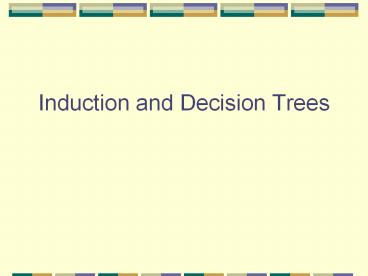Induction and Decision Trees - PowerPoint PPT Presentation
Title:
Induction and Decision Trees
Description:
Induction and Decision Trees – PowerPoint PPT presentation
Number of Views:161
Avg rating:3.0/5.0
Title: Induction and Decision Trees
1
Induction and Decision Trees
2
Artificial Intelligence
- The design and development of computer systems
that exhibit intelligent behavior. - What is intelligence?
- Turing test
- Developed in 1950 by Alan Turing (pioneer in
computer science) - Computer and human in one room
- Human interrogator in another room
- Interrogator asks questions...human OR computer
answers - If interrogator cannot tell whether the human or
the computer is answering, then the computer is
intelligent
3
Classification of AI Systems
- Knowledge Representation Systems
- Capture existing expert knowledge and use it to
consult end-users and provide decision support - Main types Rule-based expert systems, Case-base
reasoning systems, Frame-based knowledge systems,
Semantic networks - Machine Learning
- Algorithms that use mathematical or logical
techniques for finding patterns in data and
discovering or creating new knowledge - Main types Artificial neural networks, genetic
algorithms, inductive decision trees, Naïve
Bayesian algorithms, Clustering and
pattern-recognition algorithms
Data mining involves primarily a machine
learning form of AI
4
Data Mining
- Textbook definition
- Knowledge discovery in databases
- Using statistical, mathematical, AI, and machine
learning techniques to extract useful information
and subsequent knowledge from large databases - Key point identifying patterns in large data
sets
5
Microsoft SQL Server Data Mining Algorithms
- Decision Trees
- Naïve Bayesian
- Clustering
- Sequence Clustering
- Association Rules
- Neural Network
- Time Series
6
Decision Trees for Machine Learning
- Based on Inductive Logic
- Three types of logical structures commonly used
in AI systems - Deduction
- Abduction
- Induction
7
Deduction
- Premise (rule) if p then q
- Fact (axiom, observation) p
- Conclude q
- This is classical logic (Modus Ponens). If the
rule is correct, and the fact is correct, then
you know that the conclusion will be correct.
We are given the rule
8
Abduction
- Premise (rule) if p then q
- Fact (axiom, observation) q
- Conclude p
- This form of reasoning is a logical fallacy
called affirming the consequent (Post hoc ergo
propter hoc). The conclusion may be wrong, but it
is a plausible explanation of the fact, given the
rule. Useful for diagnostic tasks.
We are given the rule
9
Induction
- Observe p and q together
- .
- .
- .
- n. Observe p and q together
- Conclude if p then q
- This is stereotypical thinkinghighly error
prone.
We create the rule
10
Example Baby in the kitchen
11
ID3 Decision Tree Algorithm
- Iterative Dichotomizer
- Developed by Ross Quinlan (1979)
- This is the basis for many commercial induction
products - The goal of this algorithm is to find rules
resulting in YES or NO values. (Therefore, the
output of generated rules have 2 possible
outcomes) - ID3 generates a tree, where each path of the tree
represents a rule. The leaf node is the THEN part
of the rule, and the nodes leading to it are the
ANDS of attribute-value combinations in the IF
part of the rule.
12
ID3 Algorithm
- Starting Point
- an empty tree (this tree will eventually
represent the final rules created by ID3) - a recordset of data elements (e.g. records from a
database) - a set attributes (fields), each with some finite
number of possible values - NOTE one of the attributes is the decision
field, with a YES or NO value (or some other
2-valued option...GOOD/BAD, HIGH/LOW, WIN/LOSE,
etc.) - Output
- a tree, where each path of the tree represents a
rule
13
ID3 algorithm
- If all records in your recordset are positive
(i.e. have YES values for their decision
attribute), create a YES node and stop (end
recursion) - If all records in your recordset are negative,
create a NO node and stop (end recursion) - Select the attribute that best discriminates
among the records (using an entropy function) - Create a tree-node representing that attribute,
with n branches, where n is the number of values
for the selected attribute - Divide the records of the recordset into subsets
subrecordset 1, subrecordset 2, ..., subrecordset
n corresponding with each value of the selected
attribute - Recursively apply the algorithm to each
subrecordset i, with reduced attribute set (dont
include already used attributes further down the
path)
14
Calculating Entropy
- Entropy mixture, chaos
- We want to pick the attribute with the lowest
entropy - ? ideally, a particular value for the input
attribute leads to ALL yes or ALL no in the
outcome attributeor come as close to this as
possible
An attributes entropy
Where n is the total number of possible values
for the attribute and xi is the ith value
15
Babys RecordSet of Oven-Touching Experiences
16
ID3 Applied to Baby-in-the-Kitchen
- Which attribute to start with? Based on Entropy
measure (assuming log base 2), - Touch stove entropy 0.918
- Mom in kitchen entropy 1.0
- To see this, note that
- Probability of touching stove leading to ouch is
.67, and not leading to ouch is .33 - .67 .33 .22
- Probability of mom being in kitchen leading to
ouch is .5 and mom being in kitchen not leading
to ouch is also .5 - .5 .5 .25
17
Applying the Touch Stove Attribute
18
Recurse apply the Mom in Kitchen attribute where
needed
19
Resulting decision rules
- If Touch_Oven No then BOO_BOO No
- If Touch_Oven Yes and Mom_In_Kitchen Yes then
BOO_BOO Yes - If Touch_Oven Yes and Mom_In_Kitchen No then
BOO_BOO No
20
Now well do this with Microsoft SQL Server































